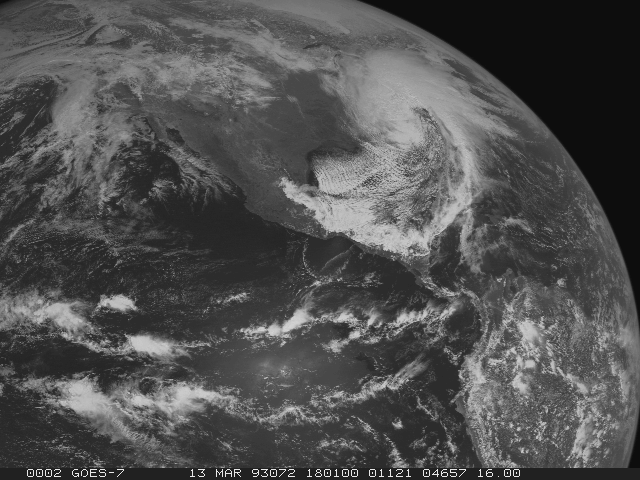



5.2 Satellite Imagery - Using Coordinate Systems
In this exercise, you will display the same image using different
coordinate types. The coordinate system and location where the
specified coordinates are positioned on the frame define the
coordinate type. The three coordinate systems are:
The two locations (PLACE) are:
- CENTER (center)
- ULEFT (upper-left corner)
The coordinate type is defined by a combination of the coordinate
system keywords and location; for example, LINELE=1121 4657 I PLACE=ULEFT
positions the (I) image coordinates (1121,4657) in the
(ULEFT) upper-left corner.
The first exercise shows that the same image can be displayed using
different coordinate types.
- Show frame 1.
- Type: SF 1
- Display the GOES-7 Full Disk Visible image on frame 1
so the element having image coordinates (1121, 4657) appears at the
upper-left corner of the frame.
- Type: IMGDISP BLIZZARD/G7-VIS-FD 1 LINELE=1121 4657 I PLACE=ULEFT
The combination of I for line/element type and PLACE=ULEFT places the
specified image coordinates in the upper-left corner. Note in the
on-line help for IMGDISP that the
default for PLACE is ULEFT when LINELE is specified and
therefore could be omitted from the command line above.
- Display the GOES-7 Full Disk Visible image on frame 2 so that
Puerto Escondido, Mexico, is at the center of the image frame.
- Type: IMGDISP BLIZZARD/G7-VIS-FD 2 STATION=MMPS;SF 2
The STATION parameter places the earth coordinates for Puerto Escondido
in the center of the frame, as shown below. When STATION or LATLON
are used, the default for PLACE is CENTER.

- Display the GOES-7 Full Disk Visible image on frame 3 so that file (area)
coordinates (240, 320) appear in the center of the image frame.
- Type: IMGDISP BLIZZARD/G7-VIS-FD 3 LINELE=282 610 F PLACE=CENTER;SF 3
The combination of F for coordinate system and PLACE=CENTER places the
specified file (area) coordinates in the center of the image frame.
- Start and then stop the loop.
- Press: Alt L
- Press: Alt L
All the images are the same, except they are displayed using different
coordinate types.
- Show frame 2 and use the PC command to
position the cursor in the center the frame. Then find the earth coordinates
of Puerto Escondido. The PC command is discussed
in more detail in the Graphics and the Cursor
lesson.
- Type: SF 2;PC C
- Press: Alt E
Command E lists the latitude and longitude of a pixel on a
navigated frame in the format DD:MM:SS. It also lists the
TV coordinates and image coordinates of the pixel.
Frame Latitude Longitude Tvline Tvelem Line Elem
2 15:48:27 097:07:46 240 320 4945 9761
Next you will display the same image three times, but change the
location of the displayed image using different coordinate types.
- Erase frames 1 through 3 and show frame 1.
- Type: ERASE I 1 3;SF 1
- Display the latest visible Meteosat-3 image on frame 1 so that the
earth coordinates 30° latitude and 89° longitude are centered
in the frame. Then position the cursor at the center of the frame and
verify that the earth coordinates are 30° latitude and 89°
longitude.
- Type: IMGDISP BLIZZARD/M3-VIS 1 LATLON=30 89
- Type: PC C
- Press: Alt E
Notice that the center of the frame has a latitude of 30:00:12 and
a longitude of 88:59:48.
- Display the image on frame 2 so that the image coordinates
(1999, 2503) are centered in the frame and show frame 2.
Then position the cursor in the center of the frame.
- Type: IMGDISP BLIZZARD/M3-VIS 2 LINELE=1999 2503 I PLACE=CENTER;SF 2
- Type: PC C
- Press: Alt E
Notice that the image coordinates (1999, 2503) are in the center of
the frame.
- Display the image on frame 3 so that the file (area) coordinates
(0,0) appear in the upper-left corner of the frame and show frame 3.
- Type: IMGDISP BLIZZARD/M3-VIS 3 LINELE=0 0;SF 3
- Change the dwell rate and then start and stop the loop.
Notice how the image position changes.
- Type: DR 10
- Press: Alt L
- Press: Alt L
Next, you will display a sequence of GOES-7 visible and infrared
images using the same earth coordinates to compare them. Display
the GOES visible images on the primary loop and the GOES infrared
images on the opposite loop.
- Display the first GOES-7 4km Visible image area on frame 1,
centering the image on earth coordinates 35° N and 75° W.
Use the SF= keyword to automatically display the frame.
- Type: IMGDISP GV4.1 1 LATLON=35 75 SF=YES
- Display the next two GOES-7 visible images on frames 2 and 3,
centering the images on coordinates 35° N and 75° W.
- Type: IMGDISP GV4.2 2 LATLON=35 75;IMGDISP GV4.3 3 LATLON=35 75
- Display the three GOES-7 infrared images on frames opposite the
GOES-7 visible images. The repeat factor (3) loads all three images
with one IMGDISP command.
- Type: IMGDISP GI4.1 OPP LATLON=35 75 REPEAT=3
You are using the same coordinates, 35° N and 75° W, to
load the images. The repeat factor 3 displays three images in sequence,
on frames 4, 5, and 6.
- Change the dwell rate and loop the images.
- Type: DR 5
- Press: Alt L
You should see the loop of the GOES visible images on frames
1 through 3.
- Toggle to the opposite loop to compare the images. Then
stop the loop.
- Press: Alt O
- Press: Alt L
- Practice comparing the images with the loop control system
commands Alt A, Alt B, Alt L, and Alt O that you learned in the
Loop Control System lesson.






